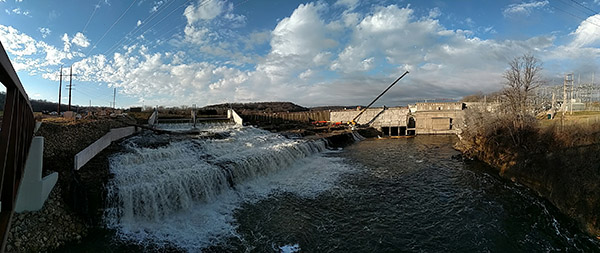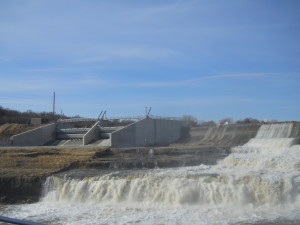Improvements Increase Dam Safety, Capacity
 Spring is in the air. Mother Nature made it official on Sunday, and Ayres Associates is following suit: The spring edition of our corporate magazine, TRENDS, went to press this week.
Spring is in the air. Mother Nature made it official on Sunday, and Ayres Associates is following suit: The spring edition of our corporate magazine, TRENDS, went to press this week.
In case your copy hasn’t arrived yet, here’s a sneak peek into what’s inside. (And if you don’t yet receive our magazine, click here to request a copy).
Our cover story addresses our firm’s past and present work at the Byllesby Dam, a high-hazard 60-foot-tall, 1,100-foot-long dam in Dakota County, Minnesota. Staff from multiple disciplines at Ayres – including water resources, engineering services, architecture, structural inspection, and survey – have all played roles in keeping the important dam operating safely and efficiently through the years.
 In the story, water resources engineer Pete Haug, who managed a recent capacity upgrade project at the dam, explains that its “high-hazard” classification means that, with the City of Cannon Falls lying just a mile downstream, “there is a very good chance people will die if the dam fails.” While the dam has never experienced such a catastrophic failure, “the safety standards are so much higher now than when the dam was built” in 1910, he says.
In the story, water resources engineer Pete Haug, who managed a recent capacity upgrade project at the dam, explains that its “high-hazard” classification means that, with the City of Cannon Falls lying just a mile downstream, “there is a very good chance people will die if the dam fails.” While the dam has never experienced such a catastrophic failure, “the safety standards are so much higher now than when the dam was built” in 1910, he says.
To bring the 105-year-old dam up to today’s standards, the Ayres team planned and supervised the resurfacing of the original concrete dam. The biggest improvement involved adding two 65-foot-wide by 14-foot-tall hydraulically operated floodgates to a spillway created just to the south of the dam.
Multiple systems were put in place to control the rate of river flow through the floodgates; now water can pass through at a rate of 37,500 cubic feet per second when the gates are fully open. “We added 80 percent more flood capacity to the dam,” Pete says. “That’s an incredible increase.”
Our spring edition also features:
- Hydraulic engineers’ efforts to study streambank stabilization.
- The aerial mapping group’s role in the award-winning Wisconsin Regional Orthophotography Consortium program.
- Transportation and traffic engineers’ insights into the techniques used to keep motorists moving through construction zones.
Is there a topic you’d like us to explore in a future edition of TRENDS? Please leave a comment below with your ideas and suggestions – or email Jennifer Schmidt of our editorial staff at SchmidtJ@AyresAssociates.com.

Post a comment: